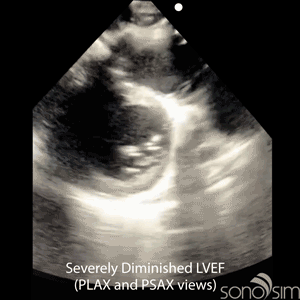Evidence is rapidly emerging that COVID-19 patients may present with a myriad of cardiac complications, including acute myocardial injury, myocarditis, and dysrhythmias (Arentz et al., Clerkin et al., Huang et al.). Historically, influenza and other upper respiratory tract infections have been associated with a higher incidence of similar conditions, including acute coronary syndromes (Kwong et al.).
Between 5 to 28% of hospitalized COVID-19 patients have been found to have a myocardial injury, as evidenced by elevated cardiac enzyme levels (Guo et al., Huang et al., Wang et al.). COVID-19 patients that had elevated troponin levels upon hospital admission were found to have significantly higher mortality rates (Guo et al., Huang et al., Wang et al.).

The pathophysiology of Severe Acute Respiratory Syndrome Coronavirus-2 (SARS-CoV-2) infections and cardiac involvement remains an area of active research. Preliminary hypotheses largely derive from cardiac manifestations of other viral infections, which include myocarditis, pericarditis, and an elevated inflammatory response contributing to coronary artery occlusion (Kühl et al., Zheng et al.). Another theory involves angiotensin-converting enzyme 2 (ACE-2) receptor-mediated direct injury to the heart (Clerkin et al., Wan et al., Zheng et al.). The ACE-2 receptors found in the lungs and hearts of humans have a high affinity for the Spike protein of SARS-CoV-2. Alveolar epithelial cells possessing ACE-2 receptors appear to be the portal for viral entry and subsequent infection.
In summary, hospitalized patients may present cardiac complications of COVID-19, with symptoms resulting from cardiac involvement, including acute-onset heart failure, myocardial infarction, myocarditis, and cardiac arrest (Arentz et al., Clerkin et al., Huang et al.). Clinicians need to be aware that COVID-19 patients may present with concurrent acute pulmonary and cardiac pathologies. Focused cardiac ultrasound (FoCUS) may play a role in the initial identification and management of cardiovascular complications in such patients.
Key Points
- COVID-19 patients may initially present with acute onset heart failure, myocardial infarction, myocarditis, and cardiac arrest.
- Five to 28% of hospitalized COVID-19 patients have demonstrated evidence of myocardial injury.
- Consider measuring troponin levels and utilizing B-type natriuretic peptide (BNP) levels to identify concurrent cardiac involvement in COVID-19 patients presenting with cardiopulmonary complaints.
- FoCUS may help manage COVID-19 patients presenting with acute myocardial injury.
Arentz M, Yim E, Klaff L, et al. Characteristics and outcomes of 21 critically ill patients with COVID-19 in Washington state. JAMA. 2020 Mar 19. doi: 10.1001/jama.2020.4326. [Epub ahead of print]
Clerkin KJ, Fried JA, Raikhelkar J, et al. Coronavirus disease 2019 (COVID-19) and cardiovascular disease. Circulation. 2020 Mar 21. doi: 10.1161/CIRCULATIONAHA.120.046941. [Epub ahead of print]
Guo T, Fan Y, Chen M, et al. Cardiovascular implications of fatal outcomes of patients with coronavirus disease 2019 (COVID-19). JAMA Cardiol. 2020 Mar 27:e201017. doi: 10.1001/jamacardio.2020.1017. [Epub ahead of print]
Huang C, Wang Y, Li X, et al. Clinical features of patients infected with 2019 novel coronavirus in Wuhan, China. Lancet. 2020 Feb 15;395(10223):497-506. doi: 10.1016/S0140-6736(20)30183-5. Epub 2020 Jan 24.
Kühl U, Pauschinger M, Noutsias M, et al. High prevalence of viral genomes and multiple viral infections in the myocardium of adults with “idiopathic” left ventricular dysfunction. Circulation. 2005 Feb;111(7): 887-893.
Kwong JC, Schwartz KL, Campitelli MA, et al. Acute myocardial infarction after laboratory-confirmed influenza infection. N Engl J Med. 2018 Jan;378(4):345-353.
Wan Y, Shang J, Graham R, et al. Receptor recognition by novel coronavirus from Wuhan: an analysis based on decade-long structural studies of SARS Coronavirus. J Virol. 2020 Mar 17;94(7). pii: e00127-20. doi: 10.1128/JVI.00127-20.
Wang D, Hu B, Hu C, et al. Clinical Characteristics of 138 Hospitalized Patients With 2019 Novel Coronavirus–Infected Pneumonia in Wuhan, China. JAMA. 2020;323(11):1061-1069. doi:10.1001/jama.2020.1585
Zheng YY, Ma YT, Zhang JY, et al. COVID-19 and the cardiovascular system. Nat Rev Cardiol. 2020 Mar 5. doi: 10.1038/s41569-020-0360-5. [Epub ahead of print]
*Information from this website is for informational and learning purposes. It is not a substitute for professional medical advice, diagnosis, or treatment, but is intended to share real-time case studies and academic articles within the medical education community.